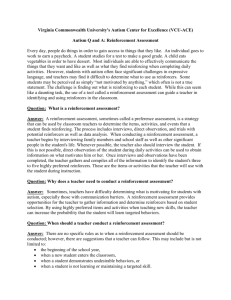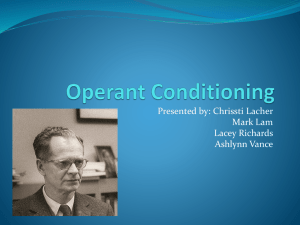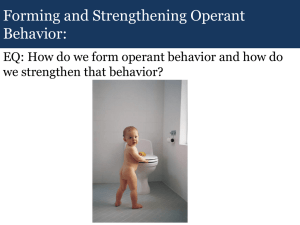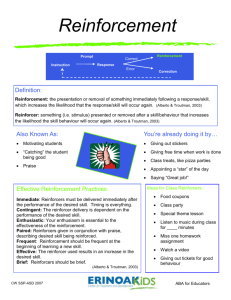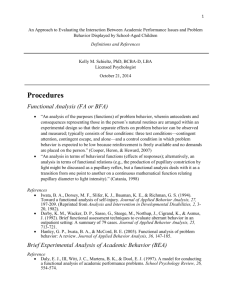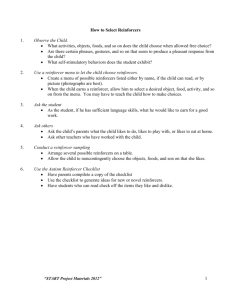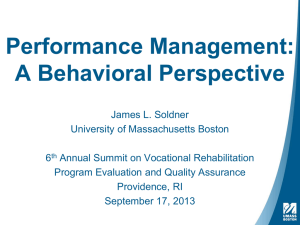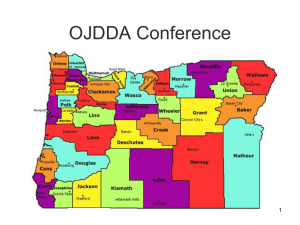Word - VCU Autism Center for Excellence
advertisement
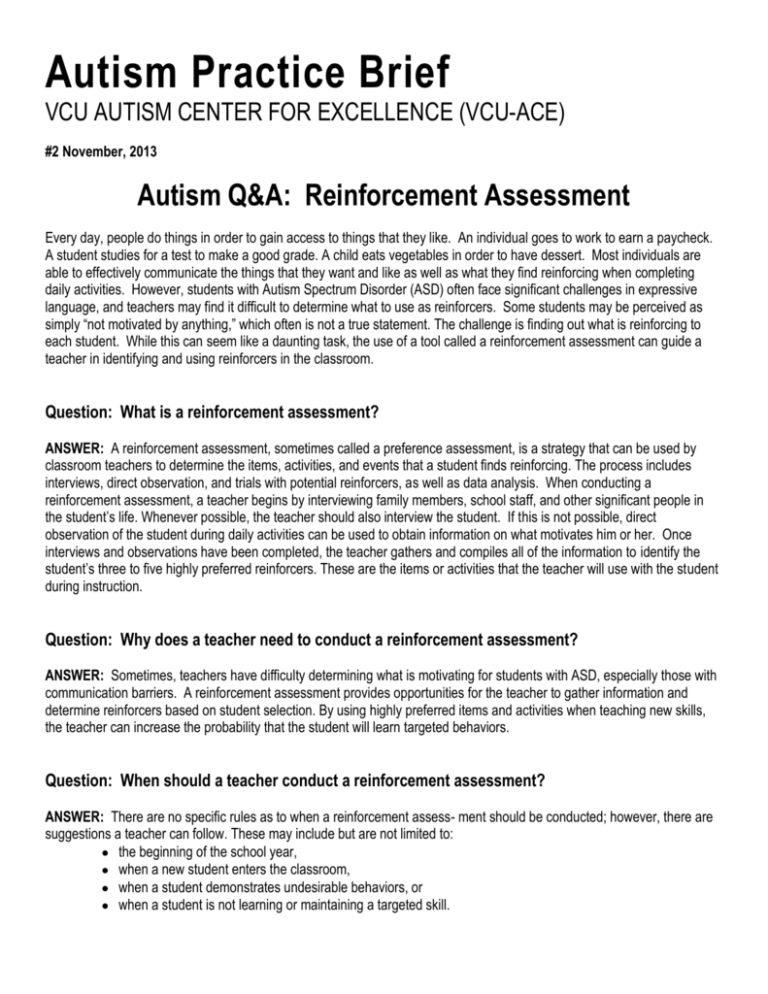
Autism Practice Brief VCU AUTISM CENTER FOR EXCELLENCE (VCU-ACE) #2 November, 2013 Autism Q&A: Reinforcement Assessment Every day, people do things in order to gain access to things that they like. An individual goes to work to earn a paycheck. A student studies for a test to make a good grade. A child eats vegetables in order to have dessert. Most individuals are able to effectively communicate the things that they want and like as well as what they find reinforcing when completing daily activities. However, students with Autism Spectrum Disorder (ASD) often face significant challenges in expressive language, and teachers may find it difficult to determine what to use as reinforcers. Some students may be perceived as simply “not motivated by anything,” which often is not a true statement. The challenge is finding out what is reinforcing to each student. While this can seem like a daunting task, the use of a tool called a reinforcement assessment can guide a teacher in identifying and using reinforcers in the classroom. Question: What is a reinforcement assessment? ANSWER: A reinforcement assessment, sometimes called a preference assessment, is a strategy that can be used by classroom teachers to determine the items, activities, and events that a student finds reinforcing. The process includes interviews, direct observation, and trials with potential reinforcers, as well as data analysis. When conducting a reinforcement assessment, a teacher begins by interviewing family members, school staff, and other significant people in the student’s life. Whenever possible, the teacher should also interview the student. If this is not possible, direct observation of the student during daily activities can be used to obtain information on what motivates him or her. Once interviews and observations have been completed, the teacher gathers and compiles all of the information to identify the student’s three to five highly preferred reinforcers. These are the items or activities that the teacher will use with the student during instruction. Question: Why does a teacher need to conduct a reinforcement assessment? ANSWER: Sometimes, teachers have difficulty determining what is motivating for students with ASD, especially those with communication barriers. A reinforcement assessment provides opportunities for the teacher to gather information and determine reinforcers based on student selection. By using highly preferred items and activities when teaching new skills, the teacher can increase the probability that the student will learn targeted behaviors. Question: When should a teacher conduct a reinforcement assessment? ANSWER: There are no specific rules as to when a reinforcement assess- ment should be conducted; however, there are suggestions a teacher can follow. These may include but are not limited to: the beginning of the school year, when a new student enters the classroom, when a student demonstrates undesirable behaviors, or when a student is not learning or maintaining a targeted skill. In addition, teachers should repeat the reinforcement assess-ment periodically as students’ interests change over time. Question: How does a teacher conduct a reinforcement assessment? ANSWER: One structured method of conducting a reinforcement assessment is a paired choice reinforcer assessment. The paired choice assessment allows the teacher to discover potential reinforcers that a student prefers, and permits the teacher to rank order the reinforcers in order of apparent student preference. The first step of the process is to collect information about the student’s preferences. This is accomplished by interviewing the student and those who are familiar with him or her. As part of this first step, the student should be observed in natural environments during free choice activities. The information collected from these activities allows the teacher to create a list of potential reinforcers. The list of reinforcers may include food, social interactions, and access to items and preferred activities. Keep in mind that reinforcers should be easy to use, readily accessible, and advance the student’s educational goals. The next step in the assessment process is to narrow the list of potential reinforcers to approximately six to ten items or activities. The assessment should be conducted when there are no distractions, and the teacher can provide full attention to the student. The assessment may take place during one or more sessions depending on the student and time availability. During the assessment, select two of the items from the student’s preferred list. Present them to the student by holding them or placing them side by side on a table. Allow the student five to 10 seconds to select one of the two items by using his or her preferred method of communication, which can include eye gaze, pointing to, or touching an item. If the student makes a selection within the specified time limit, the selection is recorded. He or she is then able to interact with the item for 30 seconds, eat the preferred food, or engage in the preferred activity. If the student does not make a selection, both items are removed, and the teacher records that a selection was not made during the trial. This process continues until all items have been paired together, and the student’s preferences are recorded. Finally, the teacher rank orders the preferences from those that are most to least often selected. Question: Please provide more information on how been offered to the student. to pair the items so that all choices have ANSWER: Let’s assume that the teacher has information from the family and observations of the student that indicate he may like to listen to music on a MP3 player, play video games, look at a football magazine, drink a soda, or eat chocolate chip cookies. The goal is to pair each of these five items with each other at least once to see if the student demonstrates any preferences for a specific item or activity. The teacher should make a data sheet to record data, as seen in the following table. As each pair is offered, the teacher circles the item/activity the student selects. In this example, the teacher has five items, which results in a minimum of ten trials if all items/activities are paired together at least once. The trials could be repeated at another time of the same day or another day of the week to determine if there is any consistency to the student’s responses. Trial 1 MP3 player Video game No choice Trial 5 Video game Magazine No choice Trial 8 Magazine Soda No choice Trial 2 MP3 player Magazine No choice Trial 6 Video game Soda No choice Trial 9 Magazine Cookie No choice Trial 3 MP3 player Soda No choice Trial 7 Video game Cookie No choice Trial 10 Soda Cookie No choice Trial 4 MP3 player Cookie No choice Question: What should the teacher do after the student’s preferences have been identified? ANSWER: Once the student’s preferences have been identified, the final step in the assessment is to test the reinforcers. The teacher tries using one of the highly preferred items or activities as a reinforcer during instruction. He or she then watches the student’s performance to determine if the reinforcer impacts skill acquisition by increasing the student’s targeted behavior(s). If an increase in performance occurs, then the teacher has successfully identified a reinforcer that can be used during instruction. Reinforcers should be changed on a regular basis to prevent reinforcement satiation. Question: Please provide an example of a student’s reinforcement assessment. ANSWER: Josh is a student who has a diagnosis of ASD, and he uses about 20 words to communicate his wants, needs, and desires. Josh presents with challenging behaviors of hitting and screaming when engaging in new and unfamiliar tasks. His teacher decided to do a reinforcement assessment to see if she could identify what motivates Josh. A reinforcement inventory was sent home to his family and after school providers. They sent the inventories back to school identifying Josh’s prefer-ences as eating food (e.g., chips, pretzels, cheese curls, gummy bears, chewing gum); using the computer; swinging on a swing; looking at books about whales; and listening to country music. Next, the teacher asked Josh’s family to bring him in early one morning so that she could complete a reinforcement assessment. She presented two items/ activities to Josh and waited to see if he picked one. When he picked an item, he got to eat the food or engage in the activity for up to 30 seconds. The teacher continued presenting the items/ activities in pairs until she presented each one of the items or activities paired together. After reviewing the data, the teacher determined that Josh’s most preferred reinforcer was gummy bears. His next preferred reinforcer was looking at books on whales. The teacher then tried using gummy bears and books on whales as reinforcers. First, she presented Josh with a new task while showing him that he would get gummy bears when finished. He completed the task and did not scream or hit her. The teacher tried again presenting another new and unfamiliar task, but this time she used a book about whales as the reinforcer and Josh again completed the task without hitting or screaming. After these trials, it was determined that gummy bears and books on whales could be used as positive reinforcers. The teacher knew that she would need to re-evaluate this on a regular basis to make sure these remained effective reinforcers for Josh. Summary Everyone has items, activities, and events that are motivating to them. The challenge is in determining what those things are and using them as reinforcers within the classroom. Due to communication difficulties for students with ASD, it may be difficult to determine preferred reinforcing items, but it is not an insurmountable task if the teacher engages the student in a reinforcement assessment. Additional Resources Berg, W.K., Wacker, D.P., & Steege, M.W. (1995). Best practices in assessment with persons who have severe or profound handicaps. In A. Thomas & J.Grimes (Eds.), Best practices in school psychology-III (3rd ed., pp.805-816). Washington, DC: National Association of School Psychologists. For additional information on ACE please go to our website: www.vcuautismcenter.org Contributors for this issue: Katherine Inge, Ph.D.; Joy Engstrom, M.Ed. & Susan Palko, M.Ed. Editor: Becky Boswell, M.B.A. Information for this Frequently Asked Questions (FAQ) is from Virginia Commonwealth University's Autism Center for Excellence (VCUACE), which is funded by the Virginia State Department of Education (Grant # 881-61172-H027A100107). Virginia Commonwealth University is an equal opportunity/affirmative action institution providing access to education and employment without regard to age, race, color, national origin, gender, religion, sexual orientation, veteran's status, political affiliation, or disability. If special accommodations or language translation are needed contact (804) 828-1851 VOICE -- (804) 828-2494 TTY.
